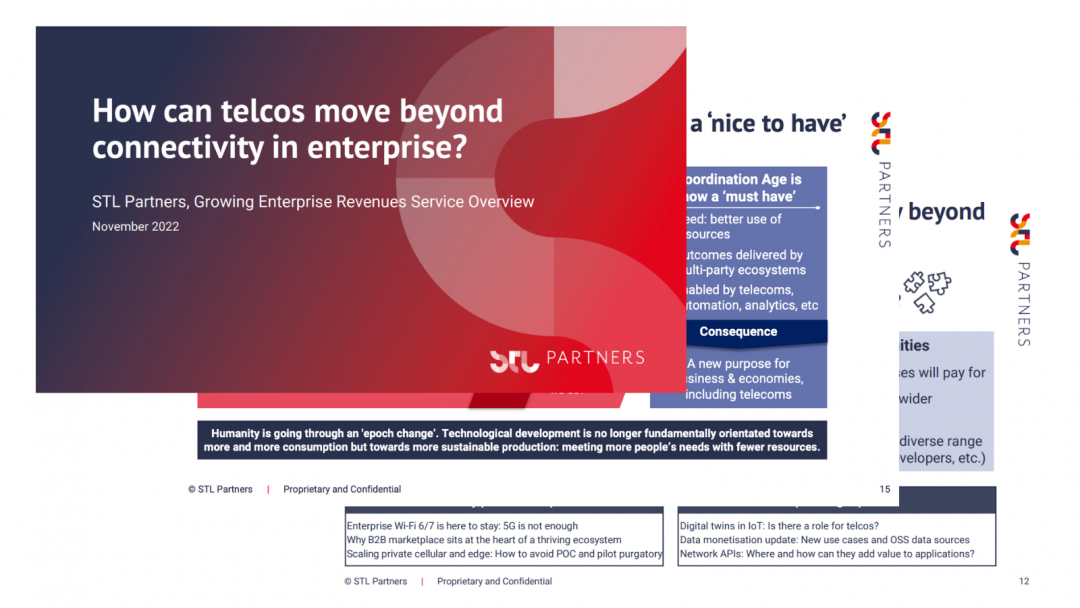
How telcos could build data exchange marketplaces
Many telcos have begun leveraging their prioprietary data or IoT businesses to deliver unique insights to enterprise customers. Could they build on these capabilities to create data exchange marketplaces?
What is a data exchange marketplace?
A data exchange marketplace is an online transactional location or store that facilitates the buying and selling of data. Data marketplaces can help enterprises reduce the effort and cost of trying to locate specific datasets and integrate them into their decision-making. They will become an increasingly essential component of our economy as enterprises become more data-driven in their operations, whether for planning the development of new product and services or to better understand their customers. For telcos, data marketplaces can be both a source of insight as well as an opportunity to grow revenues beyond connectivity by monetising their data and insights.
Globally, telcos are generating a vast variety and volume of data. With the data marketplace industry predicted to unlock more than $3.6 trillion in value for over a million organisations by 2030 telcos should view data martketplaces as a lucrative area to explore. This article will explore how telcos can leverage on existing data, vertical expertise and connections to participate in or build data marketplaces and eventually provide an engaging platform for enterprise customers to buy and share data securely.
Data monetisation: A starting point towards a data exchange marketplace
Types of data telcos can leverage
Previous research conducted by STL, Telco data monetisation: What’s it worth? identified the range and potential value ofdata monetisation use cases telcos could develop. Geolocation data and associated products which anonymise and intergrate data into telco products accounts for 80% of total financial value from standalone data and analytics products. Industries such as tourism and government could use this data to identify ‘people hotspots,’ which can help them decide where to place certain technologies e.g. CCTV, smart lighting, cafes.
How can telcos monetise this data?
There are three main ways telcos can monetise their data, from the simplest, sharing raw data feeds, to the most complex, creating an open data platform.
1. Sharing raw data feeds: this includes CRM, CDR, location, second and third party, credit checking. These types of data sets can be provided to enterprise customers for authentication. Telcos can also create triggers using raw data and share it to customers. Although some telcos do sporadically share datasets to advertising data platforms, credit scoring and authentication services, this is not common place due to data privacy risks of selling raw data.
2. Creating consumer insights/consumer movement insights: Insights generated from aggregated and anonymised telco customer data can be provided to customers. This typically includes insights drawn from demographics and customers location obtained from customer use of mobile network. The ability to monetise this customer data is dependent on the regulatory environment, a telco’s market share, its appetite for risk, and the cost of developing the data platform. This type of data would be useful for government services, advertising and IoT environments.
3. Open data platform: These are platforms where suppliers can sell their data to customers. It is not clear how many telcos submit data onto open data platforms. Ideally in the future telcos can act as orchestrators of these platforms which will support them in gaining a sustainable new revenue stream and break into the trillion dollar industry.
Figure 2: Different levels of data monetisation

Source: STL Partners
Three data marketplace strategies: Today vs the future
Some telcos have began to monetise their data externally and are now working towards a development of a data exchange marketplace. Today, most telco data marketplaces are limited in that they focus on one-to-many data/insights transactions, i.e. the telco aggregates its own data and provides insights to many customers; customers cannot securely share data or insights between one another. Although this is a good starting place it is important that marketplace orchestrators have a long term vision of expanding their platforms into places where many suppliers can offer their data to many customers in a secure and standardised way – including managing payment for access to data/insights. Ultimately it is the ability to draw insights from multiple datasets that are currently siloed which will enable enterprises to identify new patterns and solve previously.
Figure 3: Data marketplaces in the future

Source: STL Partners
Below we explore the three main approaches telcos have taken in data monetisation, and how they could expand on these to orchestrate or participate in broader data marketplaces.
Building up from vertical expertise
Some operators have invested in building capabilities within specific verticals, acquiring industry specialist IT and software companies to build revenue beyond their core connectivity services. This can be a good starting point for building a vertical-specific data marketplace.
A good example is Telus’ investment in healthcare. In 2009, Telus set out on its journey to become a pioneer in the digital transformation of healthcare and began by acquiring health claims processing and hospital software company Emergis. Its primary motivation for investment into healthcare was to create a new revenue stream as it believed that it would not be able to solely rely on connectivity for revenue growth. Telus’ flexible and long term approach enabled it to identify its core target customers in healthcare – primary care providers – and build its long term strategy to provide safe and effective data sharing between clinicians and hospitals. To achieve this, it created a three step strategy:
1. Build reach: By acquiring other healthcare IT companies it is able to build up reputation and experience in the healthcare sector, it has achieved this by aqcuiring multiple electronic medical record (EMR) and pharmacy management solutions.
2. Develop a collaborative ecosystem: Telus is using its strengths and assests as a telco to improve communication within the healthcare industry, e.g. providing secure messaging (MedDialog) and Canada’s national eprescription system.
3. Create quantifiable health outcomes: Telus aims to leverage data analytics to improve efficiency and patient health.
By following this three step strategy, Telus Health has created a digital platform, ‘health exchange international’, that connects healthcare providers and patients to each other, to health data and solutions. . The platform has high security and identity management software to protect data privacy and resolves key issues of data interoperability across the healthcare ecosystem.
Figure 4: Telus’ vision of enabling data sharing in healthcare

Source: STL Partners
Telus executives also believe that this digital platform will encourage start-ups and other IT health companies to compete and collaborate with each other giving them a fair playing field. Telus is a great example of how a telco can build on a specific vertical to establish a data marketplace that is independent of its connectivity business.
An advantage for telcos taking this vertical approach to creating a data marketplace is that they will be able to keep core enabling roles and be able to use their networks across a wide area e.g. Telus’ approach to data exchange in healthcare gave it the opportunity to use its own networks and datasystems across healthcare areas in Canada. Another benefit of exploring specific verticals such as healthcare, agriculture and manufacturing is that it gives telcos the opportunity to move away from their core functionalities by opening up new revenue streams.
Building on customer insights
Another way telcos can approach creating a data marketplace is to use their own data about customers to create insights.
Telia is an example of a telco that uses its own data to produce insights. Telia offers a service to enterprise customers called Crowd Insights which is a continuously updated subscription service. This service can support retail enterpises understand behavioural patterns of their customers e.g where they are travelling from, how time, seasons, and weather conditions affect their behaviours. For example, in 2021 the Rajalla shopping center, one of the largest in Lapland, used Telia Crowd Insights to gain a better understanding where customers travel from and which type of promotions appeal to them which supported it to manage the shopping centre’s operations.
Telia has a three step process to creating crowd insights:
1. Anonymising their customer data
2. Aggregating the data into groups of at least five indivduals to meet GDPR regulations and dividing its network into geographical areas large enough so indivduals cannot be identified
3. Analysing and extracting data retrieved from mobile and local wifi networks to identify crowd movement patterns. They identify different types of patterns: Origin-Destination Matrix reports show where people come from and how people move across the country, Routing report: provides insights into trip routes and transport choices and Activity reports: shows when people arrive at certain destinations and where they go to next.
Figure 5: Example of Telia’s crowd insights

Build up from IoT solutions
The number of IoT connections is expected to reach almost 500 million by the end of 2022. Some telcos have begun expanding their IoT businesses, creating platforms to monetise the data.
For example, Orange’s platform Live Objects enables enterprise customers and users to manage their devices/objects and data produced by their devices securely. This platform allows enterprises to transform their data into useful information to get a better understanding of their customers and their habits. Orange’s data management service within the Live Objects platform enables safe collection and storage of device data, manage events and alerts and visualisation/analysis of data. It is designed for companies operating in the industrial and service spheres.
Figure 6: Visualisation of Orange’s Live Objects platform

Although Orange has created a live IoT platform it is still a one-to-one services as it doesn’t enable enterprise customers to collaborate with each other, although this could be explored as a next stept towards developing a true data exchange platform.
Building strong revenue growth from vertically focused, customer insights, and IoT businesses has been a challenge for telecoms operators. However, for those that have made the effort of developing data management and analytics tools to expand their relationships with enterprises, it may be worth exploring how they can unlock the true power of the IoT and connected technologies. This will require enabling datasets that are currently locked-in to siloes, either within or between organisations, to be combined to create deeper insights into customer pain points and ner service opportunities.
Download this article as a PDF
Read more about growing enterprise revenues
Growing Enterprise Revenues overview pack
Our overview pack explores how the telecoms industry can leverage new business models to meet enterprise customer needs
Telco APIs and Open Gateway: You can’t make an omelette without breaking some eggs
This article provides an assessment of where the market is to date post-MWC Barcelona, and what telcos can do to accelerate the opportunity.
Telco managed cybersecurity: incorporating cloud native application security
While the move to cloud native is a top priority for many enterprises, it introduces new security risks. There are individual solutions that minimise this risk, but a unified platform can offer a holistic approach. Telcos could strengthen their offerings by incorporating such platforms into their managed security services.
The Economy of Things: enabling the monetisation of IoT data
The Economy of Things (EoT) represents the natural transition of the Internet of Things (IoT). Whilst the IoT enables the generation of data from their devices and their sensors, the EoT can provide the means for the data to be transacted and monetised across a multi-participatory ecosystem. By 2030, at STL Partners we forecast that there will be 3.3 billion EoT enabled devices worldwide.





